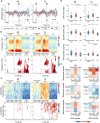Personalized targeted memory reactivation enhances consolidation of challenging memories via slow wave and spindle dynamics
- PMID: 40691439
- PMCID: PMC12280145
- DOI: 10.1038/s41539-025-00340-3
Personalized targeted memory reactivation enhances consolidation of challenging memories via slow wave and spindle dynamics
Abstract
Sleep is crucial for memory consolidation, underpinning effective learning. Targeted memory reactivation (TMR) can strengthen neural representations by re-engaging learning circuits during sleep. However, TMR protocols overlook individual differences in learning capacity and memory trace strength, limiting efficacy for difficult-to-recall memories. Here, we present a personalized TMR protocol that adjusts stimulation frequency based on individual retrieval performance and task difficulty during a word-pair memory task. In an experiment comparing personalized TMR, TMR, and control groups, the personalized protocol significantly reduced memory decay and improved error correction under challenging recall. Electroencephalogram (EEG) analyses revealed enhanced synchronization of slow waves and spindles, with a significant positive correlation between behavioral and EEG features for challenging memories. Multivariate classification identified distinct neural signatures linked to the personalized approach, highlighting its ability to target memory-specific circuits. These findings provide novel insights into sleep-dependent memory consolidation and support personalized TMR interventions to optimize learning outcomes.
© 2025. The Author(s).
Conflict of interest statement
Competing interests: The authors declare no competing interests.
Figures





Similar articles
-
Short-Term Memory Impairment.2024 Jun 8. In: StatPearls [Internet]. Treasure Island (FL): StatPearls Publishing; 2025 Jan–. 2024 Jun 8. In: StatPearls [Internet]. Treasure Island (FL): StatPearls Publishing; 2025 Jan–. PMID: 31424720 Free Books & Documents.
-
Vagal heart rate variability during rapid eye movement sleep reduces negative memory bias.Front Behav Neurosci. 2025 Feb 24;19:1513655. doi: 10.3389/fnbeh.2025.1513655. eCollection 2025. Front Behav Neurosci. 2025. PMID: 40066370 Free PMC article.
-
Slow Oscillation-Spindle Coupling Predicts Sequence-Based Language Learning.J Neurosci. 2025 Jan 15;45(3):e2193232024. doi: 10.1523/JNEUROSCI.2193-23.2024. J Neurosci. 2025. PMID: 39572236 Free PMC article.
-
Disturbed memory and amnesia related to intensive care.Memory. 2000 Mar;8(2):79-94. doi: 10.1080/096582100387632. Memory. 2000. PMID: 10829125
-
Management of urinary stones by experts in stone disease (ESD 2025).Arch Ital Urol Androl. 2025 Jun 30;97(2):14085. doi: 10.4081/aiua.2025.14085. Epub 2025 Jun 30. Arch Ital Urol Androl. 2025. PMID: 40583613 Review.
References
-
- Abdellahi, M. E., Koopman, A. C., Treder, M. S. & Lewis, P. A. Targeting targeted memory reactivation: characteristics of cued reactivation in sleep. Neuroimage266, 119820 (2023). - PubMed
-
- Diekelmann, S. & Born, J. The memory function of sleep. Nat. Rev. Neurosci.11, 114–126 (2010). - PubMed
-
- Stickgold, R. A memory boost while you sleep. Nature444, 559–560 (2006). - PubMed
Grants and funding
LinkOut - more resources
Full Text Sources

